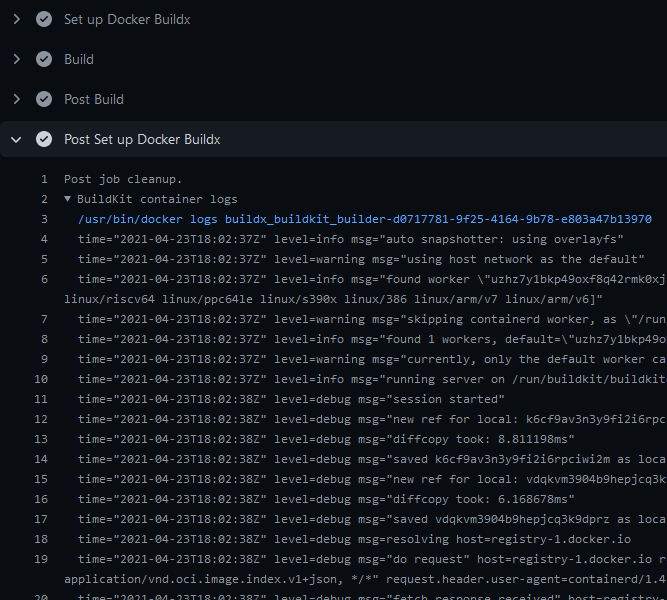BuildKit configuration (original) (raw)
Configuring your GitHub Actions builder
This page contains instructions on configuring your BuildKit instances when using our Setup Buildx Action.
By default, the action will attempt to use the latest version of Buildxavailable on the GitHub Runner (the build client) and the latest release ofBuildKit (the build server).
To pin to a specific version of Buildx, use the version input. For example, to pin to Buildx v0.10.0:
To pin to a specific version of BuildKit, use the image option in thedriver-opts input. For example, to pin to BuildKit v0.11.0:
To display BuildKit container logs when using the docker-container driver, you must either enable step debug logging, or set the --debug buildkitd flag in the Docker Setup Buildx action:
Logs will be available at the end of a job:


You can provide a BuildKit configurationto your builder if you're using thedocker-container driver(default) with the config or buildkitd-config-inline inputs:
Registry mirror
You can configure a registry mirror using an inline block directly in your workflow with the buildkitd-config-inline input:
For more information about using a registry mirror, see Registry mirror.
Max parallelism
You can limit the parallelism of the BuildKit solver which is particularly useful for low-powered machines.
You can use the buildkitd-config-inline input like the previous example, or you can use a dedicated BuildKit config file from your repository if you want with theconfig input:
Buildx supports running builds on multiple machines. This is useful for buildingmulti-platform images on native nodes for more complicated cases that aren't handled by QEMU. Building on native nodes generally has better performance, and allows you to distribute the build across multiple machines.
You can append nodes to the builder you're creating using the append option. It takes input in the form of a YAML string document to remove limitations intrinsically linked to GitHub Actions: you can only use strings in the input fields:
| Name | Type | Description |
|---|---|---|
| name | String | Name of the node. If empty, it's the name of the builder it belongs to, with an index number suffix. This is useful to set it if you want to modify/remove a node in an underlying step of you workflow. |
| endpoint | String | Docker context or endpoint of the node to add to the builder |
| driver-opts | List | List of additionaldriver-specific options |
| buildkitd-flags | String | Flags for buildkitd daemon |
| platforms | String | Fixedplatforms for the node. If not empty, values take priority over the detected ones. |
Here is an example using remote nodes with theremote driverand TLS authentication:
The following examples show how to handle authentication for remote builders, using SSH or TLS.
SSH authentication
To be able to connect to an SSH endpoint using thedocker-container driver, you have to set up the SSH private key and configuration on the GitHub Runner:
TLS authentication
You can alsoset up a remote BuildKit instanceusing the remote driver. To ease the integration in your workflow, you can use an environment variables that sets up authentication using the BuildKit client certificates for the tcp://:
BUILDER_NODE_<idx>_AUTH_TLS_CACERTBUILDER_NODE_<idx>_AUTH_TLS_CERTBUILDER_NODE_<idx>_AUTH_TLS_KEY
The <idx> placeholder is the position of the node in the list of nodes.
If you don't have the Docker CLI installed on the GitHub Runner, the Buildx binary gets invoked directly, instead of calling it as a Docker CLI plugin. This can be useful if you want to use the kubernetes driver in your self-hosted runner:
The following example shows how you can select different builders for different jobs.
An example scenario where this might be useful is when you are using a monorepo, and you want to pinpoint different packages to specific builders. For example, some packages may be particularly resource-intensive to build and require more compute. Or they require a builder equipped with a particular capability or hardware.
For more information about remote builder, seeremote driverand the append builder nodes example.